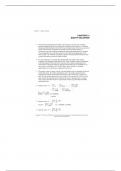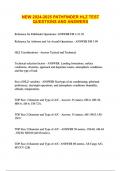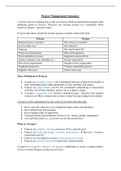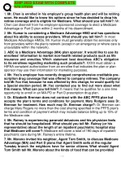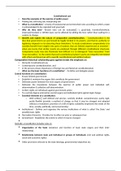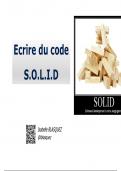Organizing strategy and entrepreneurship: theory lectures
Theory lecture 1: Introduction, Strategy (30-08-2021)
Introducing theory
- Organizing = to arrange and plan, so arrange by systematic planning and united effort
- Strategy = a careful plan or method for achieving a particular goal over a long period of time,
the skill of making or carrying out plans to achieve a goal
- Entrepreneurship = ‘’entrepreneur’’ is a person who start a business and is willing to risk loss
in order to make money, the organization, management and assumption of risks of a
business or enterprise
- The process through which (established or young) organizations engage in strategy
development and renew themselves
- Core concept: strategic renewal
Key questions
- How can organizations adapt and renew their strategies, in order to survive, remain
successful and help build a more resilient society?
o What is strategy? Which are the main components of a successful strategy?
o What is strategic renewal? What are the different ways in which organizations can
renew their strategies?
o How can organizations optimally prepare for the future? How can they survive and
remain successful in a highly dynamic and connected environment?
Introducing theory – strategy
- Five elements of strategy
1. Arena: where will the organization be active (e.g. mass market product to target a
whole country or a specific niche)
2. Vehicles: how the organization will get there (e.g. grow through organic
development; extending core competences or grow through mergers and
acquisitions)
3. Differentiators: how will the organization win customers over? (e.g. price, premium
products)
4. Staging: speed and sequence of the strategy; what actions will the organization take
5. Economic logic: how the organization will make some money? (e.g. low costs due to
scale advantages or selecting the best staff)
All of these 5 elements should be aligned with each other
- Strategic analysis of the industry, customers/marketplace trends, environmental forecast,
competitors and assessment of internal strengths, weaknesses and resources is a very
important aspect of strategy
o You need to do this analysis very thoroughly to come to a (new) strategy
- Tools for strategic analysis:
o PEST analysis, stakeholder analysis, Porter’s five forces, Porter’s value chain analysis,
SWOT analysis, BCG matrix, McKinsey’s 7s model and Ansoff matrix
- “[T]he use of strategic tools tends to draw the strategist toward narrow, piecemeal
conceptions of strategy that match the narrow scope of the tools themselves” (p. 49)
- “The key is (...) in achieving a robust, reinforced consistency among the elements of the
strategy itself.” (p. 50)
,Introducing theory – strategic renewal
- Strategic renewal = includes the process, content and outcome of refreshment or
replacement of attributes of an organization that have the potential to substantially affect its
long-term prospects
o Process: what really happens when you are doing the strategic renewal
o Content: what is being renewed
o Outcome: what the new situation is after strategic renewal
o It is always about refreshment of replacement
o Critical influence on the core of the organization; long-term
- Strategic renewal is not strategic change
o Strategic renewal is always a change, but strategic change is not always strategic
renewal
- Strategic renewal is not innovation
o Innovation can be something in the periphery, it does not always have to be about
strategy
Strategic renewal includes the process, content and outcome of refreshment or replacement of
attributes of an organization that have the potential to substantially affect its long-term prospects
Discontinuous transformation Incremental strategic renewal
Fundamental alterations of one or more aspects Continuous renewal efforts
of an organization’s strategy
Large amounts of change, and change along “[I]f undertaken proactively, [incremental
multiple dimensions renewal] may enable firms to cope with
Generally driven by major change in technology changes in the external environment as they
or customer demand take shape, and thereby reducing the need for
much larger and more difficult transformation
Receive the most attention in analyses of later on.” (p. 283)
strategic renewal Incremental alterations/experimentation
within or outside of the core business
Both discontinuous transformations and continuous incremental strategic renewal efforts
have the potential for major strategic change
Example of Amazon:
o Started as an organization selling books
o Did some discontinuous transformations with the kindle (e-reader)
o Most of their innovations were based on continuous renewal efforts; this still led to
major strategic change; nowadays they are selling a very wide range of products
,Overarching framework
Introducing theory – strategic planning
- Strategic planning
o Strategic planning is dead
“There might be those who wonder whether strategy isn’t a concept of
yesteryear, whose time has come and gone.” (Hambrick& Fredrickson, 2001:
58)
Everything changes so quickly that the moment you come up with a
new strategy is already becomes outdated
o Long live strategic planning!
The past is a good predictor of the future experimentation of design for
flexibility
Collect as much information as possible (big) data and pattern recognition
Top-down execution involvement of the whole organization
o Strategic planning for islands in a static environment
Strategic planning for connected systems in a hyper-dynamic world
Every organization is connected to other organizations and the
environment
Dynamism requires flexibility and creativity
Connectedness requires an open-systems approach and collaboration
Open system since there are multiple actors and changes in the
system
- Strategic planning is about preparing for the future
o Strategic planning is the formalized process to prepare strategic decisions
Design Experience Creativity
Logical analytical processes Adaption of past strategies based Variety and diversity of
on experience ideas/input
Planned implementation Culture/taken-for-granted Emergent strategy from within
assumptions and around the organization
Top management involvement and
commitment
, Strategy process instruments/tools that combine these elements
Participatory technique, combination of rigorous analysis and flexibility
Serious games
Introducing theory – serious gaming
- What is serious gaming / policy gaming / gaming-simulation?
o “Policy gaming uses gaming-simulation to assist organizations in policy exploration,
decision making and strategic change.” (Geurts et al., 2007, p. 535)
o Combination of tools to integrate simulation/rigor (“serious”) with
flexibility/creativity (“gaming”)
- Why serious gaming?
o Mastering Complexity
Explore the environment, helps make sense of the complex environment
o Engaging in multilogue Communication
Many different parties are communicating with each other
o Inspiring Creativity
By playing with what is going on in the organization, creativity is sparked
o Seeking Consensus
o Stimulating Commitment to action
Make sure everybody is committed to what should be done
Flexibility (dynamism) and collaboration (connectedness)
Test your understanding! (exam!)
- True or false: ‘discontinuous transformation is more challenging for organizations than
continuous incremental strategic renewal’
o Overall answer: true
o Discontinuous transformation: organization steps away from what they know and
start from zero which is more difficult than incremental renewal
o More resistance to change for discontinuous transformation
o Depends on specific things such a continuality or pro-activeness
- True or false: ‘nowadays, it is much more difficult to predict trends, and because of that
strategic planning is less important’
o Overall answer: false
o It is more difficult to predict trends, but that doesn’t mean that strategic planning is
less important than before
Key questions + answers
- How can organizations adapt and renew their strategies, in order to survive, remain
successful and help build a more resilient society?
o What is strategy? Which are the main components of a successful strategy?
Hambrick & Fredrickson (2001): An organization’s strategy consist of five
elements
A strategy is a set of intentional, informed and integrated (coherent) choices;
the key to success is coherence
Theory lecture 1: Introduction, Strategy (30-08-2021)
Introducing theory
- Organizing = to arrange and plan, so arrange by systematic planning and united effort
- Strategy = a careful plan or method for achieving a particular goal over a long period of time,
the skill of making or carrying out plans to achieve a goal
- Entrepreneurship = ‘’entrepreneur’’ is a person who start a business and is willing to risk loss
in order to make money, the organization, management and assumption of risks of a
business or enterprise
- The process through which (established or young) organizations engage in strategy
development and renew themselves
- Core concept: strategic renewal
Key questions
- How can organizations adapt and renew their strategies, in order to survive, remain
successful and help build a more resilient society?
o What is strategy? Which are the main components of a successful strategy?
o What is strategic renewal? What are the different ways in which organizations can
renew their strategies?
o How can organizations optimally prepare for the future? How can they survive and
remain successful in a highly dynamic and connected environment?
Introducing theory – strategy
- Five elements of strategy
1. Arena: where will the organization be active (e.g. mass market product to target a
whole country or a specific niche)
2. Vehicles: how the organization will get there (e.g. grow through organic
development; extending core competences or grow through mergers and
acquisitions)
3. Differentiators: how will the organization win customers over? (e.g. price, premium
products)
4. Staging: speed and sequence of the strategy; what actions will the organization take
5. Economic logic: how the organization will make some money? (e.g. low costs due to
scale advantages or selecting the best staff)
All of these 5 elements should be aligned with each other
- Strategic analysis of the industry, customers/marketplace trends, environmental forecast,
competitors and assessment of internal strengths, weaknesses and resources is a very
important aspect of strategy
o You need to do this analysis very thoroughly to come to a (new) strategy
- Tools for strategic analysis:
o PEST analysis, stakeholder analysis, Porter’s five forces, Porter’s value chain analysis,
SWOT analysis, BCG matrix, McKinsey’s 7s model and Ansoff matrix
- “[T]he use of strategic tools tends to draw the strategist toward narrow, piecemeal
conceptions of strategy that match the narrow scope of the tools themselves” (p. 49)
- “The key is (...) in achieving a robust, reinforced consistency among the elements of the
strategy itself.” (p. 50)
,Introducing theory – strategic renewal
- Strategic renewal = includes the process, content and outcome of refreshment or
replacement of attributes of an organization that have the potential to substantially affect its
long-term prospects
o Process: what really happens when you are doing the strategic renewal
o Content: what is being renewed
o Outcome: what the new situation is after strategic renewal
o It is always about refreshment of replacement
o Critical influence on the core of the organization; long-term
- Strategic renewal is not strategic change
o Strategic renewal is always a change, but strategic change is not always strategic
renewal
- Strategic renewal is not innovation
o Innovation can be something in the periphery, it does not always have to be about
strategy
Strategic renewal includes the process, content and outcome of refreshment or replacement of
attributes of an organization that have the potential to substantially affect its long-term prospects
Discontinuous transformation Incremental strategic renewal
Fundamental alterations of one or more aspects Continuous renewal efforts
of an organization’s strategy
Large amounts of change, and change along “[I]f undertaken proactively, [incremental
multiple dimensions renewal] may enable firms to cope with
Generally driven by major change in technology changes in the external environment as they
or customer demand take shape, and thereby reducing the need for
much larger and more difficult transformation
Receive the most attention in analyses of later on.” (p. 283)
strategic renewal Incremental alterations/experimentation
within or outside of the core business
Both discontinuous transformations and continuous incremental strategic renewal efforts
have the potential for major strategic change
Example of Amazon:
o Started as an organization selling books
o Did some discontinuous transformations with the kindle (e-reader)
o Most of their innovations were based on continuous renewal efforts; this still led to
major strategic change; nowadays they are selling a very wide range of products
,Overarching framework
Introducing theory – strategic planning
- Strategic planning
o Strategic planning is dead
“There might be those who wonder whether strategy isn’t a concept of
yesteryear, whose time has come and gone.” (Hambrick& Fredrickson, 2001:
58)
Everything changes so quickly that the moment you come up with a
new strategy is already becomes outdated
o Long live strategic planning!
The past is a good predictor of the future experimentation of design for
flexibility
Collect as much information as possible (big) data and pattern recognition
Top-down execution involvement of the whole organization
o Strategic planning for islands in a static environment
Strategic planning for connected systems in a hyper-dynamic world
Every organization is connected to other organizations and the
environment
Dynamism requires flexibility and creativity
Connectedness requires an open-systems approach and collaboration
Open system since there are multiple actors and changes in the
system
- Strategic planning is about preparing for the future
o Strategic planning is the formalized process to prepare strategic decisions
Design Experience Creativity
Logical analytical processes Adaption of past strategies based Variety and diversity of
on experience ideas/input
Planned implementation Culture/taken-for-granted Emergent strategy from within
assumptions and around the organization
Top management involvement and
commitment
, Strategy process instruments/tools that combine these elements
Participatory technique, combination of rigorous analysis and flexibility
Serious games
Introducing theory – serious gaming
- What is serious gaming / policy gaming / gaming-simulation?
o “Policy gaming uses gaming-simulation to assist organizations in policy exploration,
decision making and strategic change.” (Geurts et al., 2007, p. 535)
o Combination of tools to integrate simulation/rigor (“serious”) with
flexibility/creativity (“gaming”)
- Why serious gaming?
o Mastering Complexity
Explore the environment, helps make sense of the complex environment
o Engaging in multilogue Communication
Many different parties are communicating with each other
o Inspiring Creativity
By playing with what is going on in the organization, creativity is sparked
o Seeking Consensus
o Stimulating Commitment to action
Make sure everybody is committed to what should be done
Flexibility (dynamism) and collaboration (connectedness)
Test your understanding! (exam!)
- True or false: ‘discontinuous transformation is more challenging for organizations than
continuous incremental strategic renewal’
o Overall answer: true
o Discontinuous transformation: organization steps away from what they know and
start from zero which is more difficult than incremental renewal
o More resistance to change for discontinuous transformation
o Depends on specific things such a continuality or pro-activeness
- True or false: ‘nowadays, it is much more difficult to predict trends, and because of that
strategic planning is less important’
o Overall answer: false
o It is more difficult to predict trends, but that doesn’t mean that strategic planning is
less important than before
Key questions + answers
- How can organizations adapt and renew their strategies, in order to survive, remain
successful and help build a more resilient society?
o What is strategy? Which are the main components of a successful strategy?
Hambrick & Fredrickson (2001): An organization’s strategy consist of five
elements
A strategy is a set of intentional, informed and integrated (coherent) choices;
the key to success is coherence


